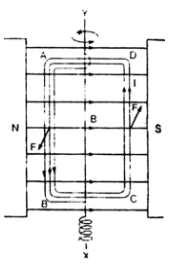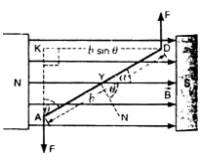Obtain the formula, I = k θ for a moving coil galvanometer, given, the deflecting torque ![]() where m is the magnetic dipole moment of the coil placed in the magnetic field B, I is the current in the galvanometer and θ is the deflection.
where m is the magnetic dipole moment of the coil placed in the magnetic field B, I is the current in the galvanometer and θ is the deflection.
Suppose the rectangular coil ABCD having n turns is of length and breadth b is placed in magnetic field B.
When current is passed through the coil, forces act on all the arms of the coil. DA and BC being equal and opposite, cancel the effect of each other. If current is passed in the direction of ABCD, then force on arm AB,
F = n B Il (normally outwards)
and
Force on arm CD, F = n B Il (normally inwards)
The two forces are equal, opposite, parallel and act at different points as shown in above figure.
Hence, the two forces constitute a torque.
As the coil rotates under the effect of the torque, the suspension wire gets twisted and restoring torque is developed in the suspension wire.
The coil will rotate, till the deflecting torque acting on the coil due to flow of current is balanced by the restoring torque developed in the suspension wire due to twisting.
Therefore, in equilibrium,
Deflecting torque = restoring torque (in magnitude)
Suppose the coil comes to rest after rotating through an angle 0. In this position, the plane of the coil makes angle θ. with the direction of the field as shown in Fig. 
The perpendicular distance between the forces acting on arms AB and CE is given by
DK = AD cos θ = b cos θ.
Therefore, deflecting torque acting on coil = either force x DK = n B I l x b cosθ= n BI A cosθ.
Where A = l x b is the area of the coil. If k is the restoring torque per unit twist for the material of the suspension wire, then restoring torque = kθ.
Since in equilibrium, the restoring torque is just equal and opposite the the deflecting torque,
n B I A cos θ= kθ
I = ![]()
Since the factor, ![]() , is constant for the given galvanometer.
, is constant for the given galvanometer.
I ![]()
As the deflection (θ) produced is not directly proportional to the current (I) passing through the galvanometer, a linear scale cannot be used for measuring the current.
In order that deflection produced in the coil of the galvanometer may be directly proportional to the current passed, the poles of the magnet are made concave so as to produce radial magnetic field.
In such a field, the plane of the coil is parallel to the magnetic lines of force in all positions of the coil figure and hence perpendicular distance between the forces on the two arms of the coil is always equal to 6, the breadth of the coil. 
Therefore, in case of radial magnetic field,
Deflecting torque = nBIl x v = n BIA
In equilibrium,
nBIA = k![]()
![]()
I = Gθ
where, ![]() , is constant for a galvanometer and is called galvanometer constant.
, is constant for a galvanometer and is called galvanometer constant.
Hence, I ∝ θ
I = k ![]()
